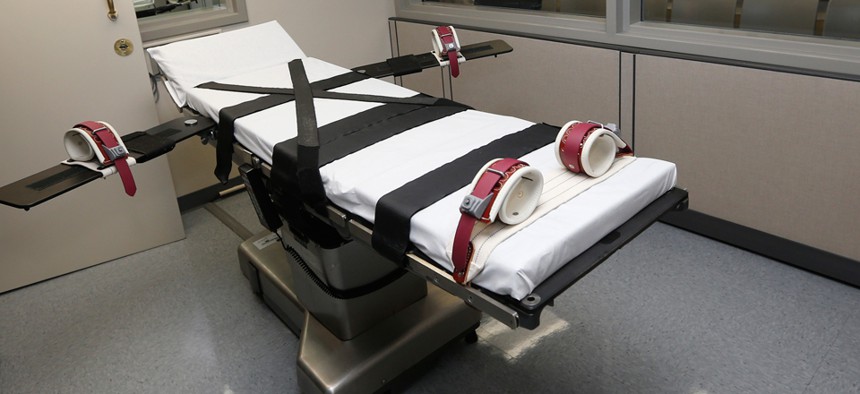A Paradoxical Reaction in Oklahoma

Sue Ogrocki/AP file photo
What if the greatest threat to the death penalty isn't its opponents, but its supporters?
In the states in which it's practiced most often, the death penalty remains overwhelmingly popular. The Supreme Court seems uninterested in revisiting its core decisions on American capital punishment, preferring instead to tinker on the margins of the machinery of death. In many ways, its legal and constitutional footing has never been more secure. One state's determination to execute could change that. And paradoxically, it could be the ardor of the death penalty's proponents, not its detractors, that imperils its constitutionality.
Tonight, the state of Oklahoma plans to inject 500 milliliters of midazolam in Charles Warner's body to sedate him, followed by 100 milliliters of pancuronium bromide and 240 milliequivalents of potassium chloride to kill him. Sentenced to death in 1999 for the rape and murder of an 11-month-old girl two years earlier, Warner has spent almost two decades on death row. The state originally scheduled his execution for April 29 last year. Two inmates' executions were planned for that night. Clayton Lockett, who had been on death row since 2000, was to be executed first, and then Warner was to follow.
But Lockett's execution took a grisly turn. Witnesses later testified that the execution was "a bloody mess." While under sedation from midazolam, Lockett began moaning and writhing after being injected with the next two drugs in the cocktail. An improper IV placement had missed Lockett's femoral artery, pumping the cocktail directly into his leg and groin muscles. When the staff lifted the sheet (they had covered Lockett's groin to respect his dignity) and inspected the IV, they found blood and other fluids pooling there. Lockett died of a massive heart attack shortly thereafter. Oklahoma Governor Mary Fallin stayed Warner's execution in the aftermath; no executions have been performed in the state since then.
Lockett and Warner's executions had already caused a constitutional crisis in Oklahoma as their execution date neared. On April 21, the Oklahoma Supreme Court intervened and stayed both defendants' executions amid concerns about a state-secrecy law that shielded the identities of lethal injection drug suppliers from activists, defendants, and the public. The surprise move—Oklahoma's supreme court does not normally hear criminal cases—sparked outrage among the state's elected politicians. Governor Fallin, a Republican, issued an executive order the next day that scheduled a new execution date in direct defiance of the court's stay. State legislators also drafted a resolution to impeach the justices who delayed the execution. The court, whose nine justices include six Democratic appointees, backed down the next day and upheld the secrecy law as constitutional.
Political considerations deeply shape the death penalty in Oklahoma, where it remains popular even amid a nationwide decline in support. Two months after Lockett's botched execution, a Tulsa World poll found that 74 percent of Oklahomans support the death penalty. (The national average hoverssomewhere around 60 percent.) According to court documents, the state attorney general's office recommended the drug to Michael Oakley, the department of corrections' general counsel at the time, when the standard lethal-injection drugs couldn't be obtained.
“[T]he Attorney General’s office, being an elective office, was under a lot of pressure,” Oakley testified. “The staff over there was under a lot of pressure to say, ‘Get it done,’ you know.” Oakley, who has no medical training, testified that he approved the drug after consulting general counsels in other states and Wikipedia.
I did have a discussion with our medical director at the time and he said, "Yeah Midazolam probably when administered will, will render sedation." And that’s all he would say. Then, you know, I did my own research, I looked on-line, you know. Went past the key Wiki leaks, Wiki leaks or whatever it is, and I did find out that when administered, Midazolam would administer, would render a person unconscious. That’s what we needed … So we thought it was okay.
Warner's lawyers contend that midazolam isn't an acceptable substitute for sodium thiopental, the standard anesthetic used in lethal injections. They make a compelling case.
Although Oklahoma uses it for sedation in executions, the FDA doesn't even approve the use of midazolam as the sole anesthetic in standard surgical procedures. Because the drug has a ceiling effect, increasing the dosage does not necessarily increase its effectiveness. In Arizona's botched execution of Joseph Wood last July, where he spent nearly two hours gasping for air in apparent agony before finally dying, the state's two-drug protocol used 750 ml of midazolam, a full seven-and-a-half times more than Oklahoma used on Lockett last year and 250 ml more than what will be used in Warner's execution tonight.
Even more troubling is midazolam's dark side. The drug is most often used to sedate patients in intensive case and to treat seizure disorders. But in patients with histories of aggression, substance abuse, and psychiatric disorders, midazolam can trigger a "paradoxical reaction," agitating the patients it is supposed to anesthetize. When administered during an execution, a drug meant to humanely sedate a death-row inmate can instead send them into a state of chemically-induced fear, anxiety, and aggression in their final moments.
Why does the anesthetic matter so much? In the 2007 case of Baze v. Rees, the Supreme Court sanctioned a specific three-drug cocktail for executions. First, sodium thiopental is used to sedate the defendant. Next, pancuronium bromide induces paralysis and stops their breathing. Finally, potassium chloride stops the defendant's heart. Without an effective sedative, the other two drugs in theBaze cocktail—the paralytic drug and the potassium chloride—cause immediate, excruciating pain for the defendant. "It is uncontested that failing a proper dose of sodium thiopental to render the prisoner unconscious," Chief Justice John Roberts wrote for the six-justice majority in Baze, "there is a substantial, constitutionally unacceptable risk of suffocation from the administration of pancuronium bromide and of pain from potassium chloride."
Of the three drugs listed by the court, sodium thiopental is the least-used in standard medical practice and therefore the hardest to obtain. In recent years, anti-death-penalty activists and abolitionists exploited this scarcity by targeting its supply chain. Hospira, the last U.S. pharmaceutical company to market sodium thiopental, ceased production in 2011 amid pressure from Italy, where the drug had been manufactured. Later that year, the European Union bannedexports of certain anesthetic drugs to the U.S. for use in lethal injections as part of its campaign for universal abolition of the death penalty. Europe's large pharmaceutical industry gives them significant leverage: In 2013, Missouri Governor Jay Nixon halted an execution after EU officials threatened to impose export controls on propofol, a common anesthetic, if the state used a German-made supply of it for lethal injections.
With sodium thiopental all but unavailable, states began hunting for new drugs to fill the gap. Some switched to one-drug protocols, although these are also vulnerable to shortages: Texas, for example, now only has enough pentobarbital for five executions. Other states, like Oklahoma, simply tried to alter the existing three-drug protocol with new sedatives. The medical community, by and large, abstains from participation in capital punishment on ethical grounds. The FDA also refuses to certify drugs for lethal injections. Instead, the cocktails are chosen by state officials who often lack medical or pharmacological training. A member of the European Parliament I spoke with last year called it human experimentation.
Will the Supreme Court intervene now? To challenge a lethal injection protocol's constitutionality, the condemned must establish that it "creates a demonstrated risk of severe pain," especially when compared to available alternatives. It's hard to think of a better demonstration than three botched executions with midazolam in three different states. In their brief, Warner's lawyers argue they've met this high threshold.
In Baze, the risks associated with the use of sodium thiopental were those created by inadequate dosing and maladministration. With midazolam, there is no dose that can reliably maintain unconsciousness at the surgical plane of anesthesia, and increasing the dose cannot overcome the risk.Simply put, even the proper administration of midazolam results in an inhumane execution.
Chief Justice Roberts noted in Baze that the Supreme Court has never struck down a method of execution in active use as unconstitutional. But Oklahoma's procedure could break that precedent.
The Supreme Court might refuse to hear this particular case, but the justices cannot avoid the questions raised by it forever. Death penalty proponents claimed that lethal injection would make executions more humane than hangings, electrocution, or the gas chamber. The recent spate of botched, tortuous executions cast doubt on that assertion. In the ultimate paradoxical reaction, public enthusiasm for the death penalty—and the political consequences thereof—may have only hastened its demise.






